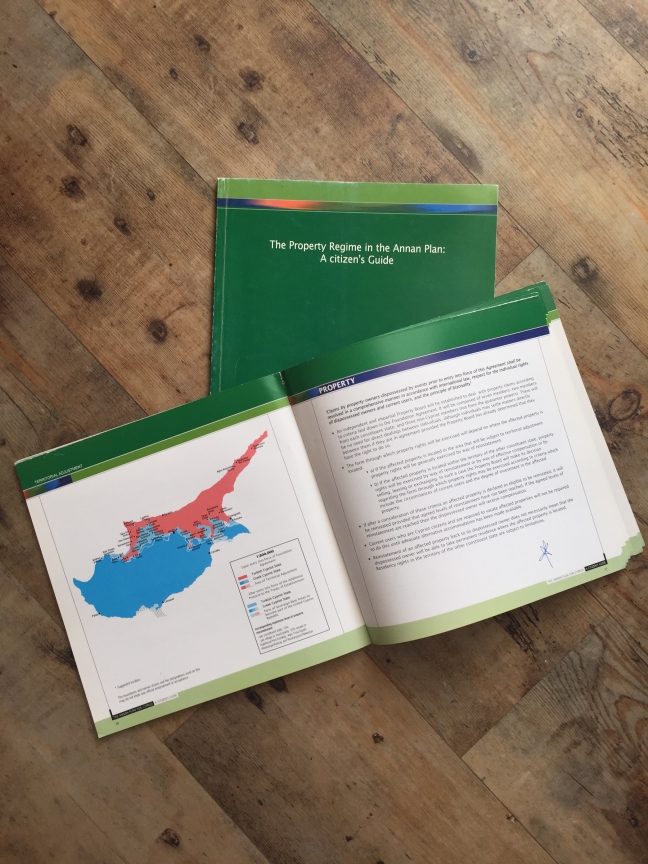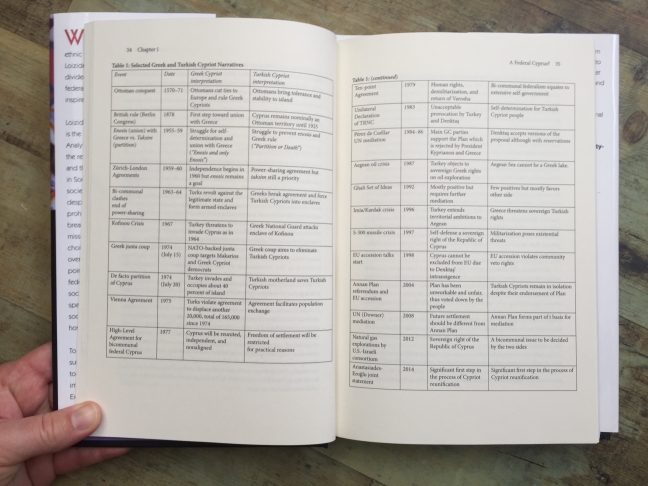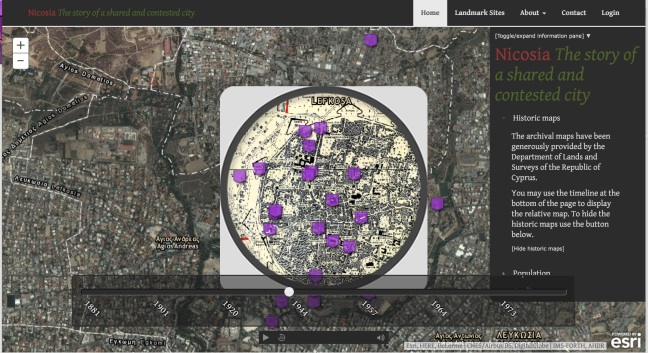This post sets out some of my initial exploratory work for a wider project on the use of design thinking and practice by civil society actors in relation to econolegal aspects of the current talks on the possible reunification of Cyprus. It is an early insight into my work in progress, it is directed towards a non-specialist audience, it is brief and leaves out far more than it includes. Thanks to the Socio-Legal Studies Association for funding fieldwork training related to this project in June-December 2016.
The key message is that existing graphic practice of reconciliation-oriented Cypriot civil society actors ranges widely in terms of message, audience, media and style. Here I have divided loosely by purpose.
Education
The PRIO Cyprus Centre produced these printed public information brochures as accessible introductions to the failed 2004 ‘Annan’ reunification plan. The typography and images are fairly typical of public policy documents.

Meanwhile, in Designing Peace: Cyprus and institutional innovations in divided societies (2016) UK-based academic Neophytes Loizides uses a table to place the parallel histories of Greek Cypriots and Turkish Cypriots on the same line of the same page.

Education
The Cypriot Puzzle has animated issues such as Cypriot ethnographic history (2016), the legal history of Cyprus (2014) and the legal intricacies of the bi-zonal bi-communal federation currently under negotiation (2014).
SeeD (2016) uses information design, distributed via social media, to communicate data from the SCORE Index. The Index tracks levels of trust, especially between Turkish Cypriots and Greek Cypriots, seen as indicators of the likelihood of reunification. The data are available in interactive form on the website.
Nicosia: The story of a shared and contested city, a project by Association for Historical Dialogue and Research (2016), allows users to move through demographic and cultural time in the divided city of Nicosia between 1878 and 1974, overlaid with contemporary music.

Perhaps most radical is Hands on Famagusta’s (2015) interactive 3D model which allows members of the public to sketch possible futures for the town Varosha which has been deserted since the 1974 Turkish invasion.
Dialogue and critique
The Cyprus Dossier was ‘an intellectual platform with the aim of initiating frequent cross-disciplinary dialogue on social and cultural issues faced by the island’s inhabitants, as diversely and impartially as possible’. It ran for 8 issues, contained no advertising, and was distributed for free. It stood out for its expressive use of typography and mix of media and topics.
By contrast Lia Lapithi Shukuroglou use performance and metaphor to explore the, often ironic, continuities of the so called Cyprus Problem. For example, in ‘Tsakistes: Recipe for marinated crushed olives’ (2006) she uses the traditional Cypriot recipe for preparing olives as a device for exposing themes of division, bitterness and festering.
In ‘I stand here ironing’ (2016) the artists riffs on a a well known short story by Tillie Olsen to explore themes of parental guilt (Greece), and troubling questions from the subaltern (Cyprus).
‘”White-Desire” ICE-CREAM Re-materializing Post-colonial Cyprus’.(2015) builds on a recipe that was based on all-white imported ingredients published 1960s by the Larnaka ladies society in the early 1960’s and still used today. The recipe, and the hunger for it act as a metaphor for the impact of colonialism on all aspects of culture and identify, including desire to be ‘white’.
‘The Shroud of Cyprus’(2015) sees two simultaneous video sequences: one of an abandoned old flag fluttering in the breeze, the other of a professional conservationist ‘repairing’ a flag (white cutout island of Cyprus onto white background) using pins in place of cities to hold it in place and then stitching. The commentary is ostensibly about conservation techniques but merges into discussion of creating and preserving identities; and what is worth preserving.
In ‘Asia Minor diary in karamanlidika text’ (2015) pages are turned on a book containing karamanlidika text (Turkish words written in Greek alphabet as was customary for a community of Turkish-speaking Orthodox Christians in Ottoman Turkey) on the one side (a diary?) and selected trilingual (Greek, Turkish, English) translations of words on the other. We hear the artist reading aloud from the text eventually joined by superimposed image of her reading through the text with a Turkish-speaking man who points out words that he understands.



